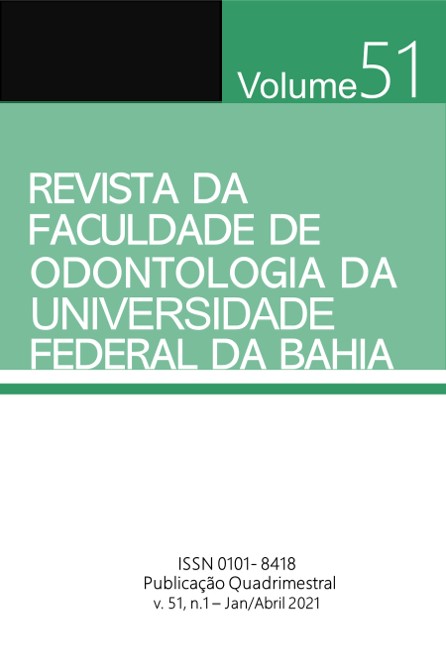SÍNDROME DE CORNÉLIA DE LANGE EM BEBÊ ASSOCIADA À DOENÇA DE RIGA FEDE TARDIA: RELATO DE CASO LANGE CORNELIA SYNDROME IN A BABY ASSOCIATED WITH LATE RIGA FEDE DISEASE: CASE REPORT
DOI:
https://doi.org/10.9771/revfo.v51i1.44216Palavras-chave:
Síndrome de Cornélia de Lange, Deficiência intelectual, Úlcera, Lange Syndrome, Intellectual Disability, UlcerResumo
Objetivo: Este trabalho tem como objetivo relatar o atendimento odontológico relacionado à doença de Riga-Fede de uma criança de 2 anos e 4 meses de idade, do sexo feminino, que apresenta síndrome de Cornélia de Lange. Descrição do Caso: A síndrome de Cornélia de Lange (CdLs) é uma condição rara com manifestação multissistêmica caracterizada por deficiência no desenvolvimento, dismorfismo facial típico, comprometimento no crescimento e anormalidades em múltiplos órgãos, incluindo alterações em mãos e pés, más-formações renais e cardiovasculares, além de alterações do desenvolvimento neurológico. Problemas odontológicos frequentemente incluem a presença de palato profundo e ogival, micrognatia, atraso na irrupção dentária, doença periodontal e automutilação da língua. Este artigo relata o tratamento de uma criança atendida na clínica de odontologia para pacientes com necessidades especiais Hospital de Ensino Odontológico da Universidade Federal do Rio Grande do Sul (UFRGS), pois apresentava uma lesão traumática no ventre lingual conhecida como úlcera de Riga Fede. A lesão foi removida através de biópsia excisional, com todos os cuidados necessários em nível ambulatorial. Conclusões: A identificação das comorbidades associadas à Síndrome de Cornélia de Lange é de fundamental importância para uma condução segura do atendimento clínico. O profissional deve ter conhecimentos sobre as alterações que ocorrem na cavidade bucal do paciente com CdLs, conhecendo as possíveis lesões patológicas comumente associadas a síndrome.
Objective: This study aims to report the dental care related to the Riga-Fede disease of a 2.4 years old child, female, who has Cornelia de Lange syndrome. Case Description: Cornelia de Lange syndrome (CdLs) is a rare condition with multisystemic manifestation characterized by developmental impairment, typical facial dysmorphism, impaired growth and abnormalities in multiple organs, including changes in hands and feet, renal and cardiovascular malformations, in addition to changes in neurological development. Dental problems often include the presence of a deep and pointed palate, micrognathia, delayed tooth eruption, periodontal disease and self-mutilation of the tongue. This article reports the treatment of a child at the dental clinic for patients with special needs at the Dental Teaching Hospital of the Federal University of Rio Grande do Sul (UFRGS), as she presented a traumatic lesion in the lingual belly, known as Riga Fede ulcer. The lesion was removed by excisional biopsy with all necessary care on an outpatient basis. Conclusions: The identification of comorbidities associated with Cornelia de Lange Syndrome is of fundamental importance for the safe conduct of clinical care. The professional must have knowledge about the changes that occur in the oral cavity of the patient with CdLs, knowing the possible pathological lesions commonly associated with the syndromes.
Downloads
Downloads
Publicado
Como Citar
Edição
Seção
Licença
Copyright (c) 2021 Revista da Faculdade de Odontologia da UFBA

Este trabalho está licenciado sob uma licença Creative Commons Attribution-NonCommercial 4.0 International License.

